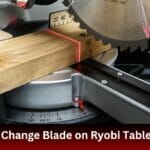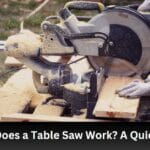The height of a table saw can considerably affect how you use it, and the height most ideally suited can be anything between 30 and 40 inches. Most woodworkers use a 34-inch table saw height because it is the most practical. But the real question is, how high should a table saw be based on your height and personal preference? Luckily, we tackle that in this article!
What is the Standard Height for Table Saws?
The optimal table saw height depends on the user’s size and height and is the one that is most comfortable for them to use.
For instance, the average male height in the United States is 1.77m, 69.1 inches, or roughly 5 feet 9 inches tall. In contrast, the average male height in Europe is a little higher at 1.80m, 70.9 inches, or approximately 5 feet 10 inches tall. This means that table saws sold in Europe would be generally higher than those sold in the USA.
Table saws are intended to accommodate the various typical heights because most manufacturers create their products for specific markets. Additionally, various designs bring some variety. Some may feature movable feet that offer a limited range of adjusting the table height.

How to Determine What Size Table Saw Fits You?
The simplest approach to determine how high should a table saw be for you is to see if the table is high enough to prevent your back from bending. That table saw won’t serve you better in the future if you have to stoop to put your hands on it with your back bent. You’ll experience ongoing back pain, which might hinder your productivity and have long-term effects.
If you intend to get a table saw from a physical store, you can go there and look at the various models. Then you can choose one that has enough height to prevent your back from bending in any way.
But if you intend to purchase your table saw online, what height will you pick? Not to worry!
We have a simple answer for that. Find a table in your home, use it as a table saw, pretend a plank has just been placed on it, and then check to see whether you’ve hunched your back. If so, you will need to raise the width by a few inches in order to achieve the ideal table saw for your purposes.
If not, you’ll be happy with that table’s size and can measure the length to find out how high it is.
But what about portable table saws, which are also available, as we are all aware? Can you efficiently and precisely change their height? Let’s find out!

Can You Alter The Height Of Portable Table Saws?
Indeed, portable table saws can provide excellent portability to woodworkers, and because of this, they also draw a lot of consumers.
In addition to portability, you still need to purchase a table on which to set the table saw. You need to select a table that can give you stability while working in addition to just a table. If your table vibrates all the time excessively, you cannot reasonably expect to work more effectively.
In addition, portable table saws are typically not as sturdy as traditional table saws. After using your table saw for several months, you could have to deal with a number of shattered pieces. So feel free to take chances if you so desire. If not, we’ll urge you to continue with conventional table saws.
Can You Adjust the Table Saw Height With The Mobile Base?
Because manufacturers offer a variety of ways to alter the height, it might be challenging to adjust the table saw height with a mobile base.
The table saw height can be changed using a lever, a hydraulic system, or a straightforward screw system. However, if you order one that is custom manufactured, you will be able to maintain the desired height.
If you want to learn how to make a bevel cut with a table saw, click here.
Other Factors to Consider in Selecting a Table Saw Blade
1. Price
The price of a table saw will be a major deciding factor for the majority of buyers. Depending on the brand, table saws that come with stands range greatly in price, but the top-of-the-line ones with all the bells and whistles can approach $600. However, you can purchase a secondhand one for considerably less.
A similar type without a stand on a portable table saw costs significantly less, often less than half as much. For a base model from a respectable manufacturer, you should budget at least $150.
If you’re interested in learning more, feel free to check out our guide on how much are used table saws worth!
2. Versatility
A decent table saw will be adaptable and useful for a range of tasks for the novice woodworker. Even though amateur woodworkers rarely cut hundreds of feet of lumber every day, they can have a project that calls for multiple distinct cuts.
The needs of the typical consumer will be well met by an easily adjustable table saw. On the other hand, a contractor or company with a high lumber throughout will probably opt for a heavier-duty saw with a more powerful motor that can withstand prolonged use.
3. Blade
Due to the fact that most customers lack the need, resources, or space for several pieces of equipment, their table saws must be able to serve a variety of purposes.
Blade adjustability is a crucial component. The blade should be able to tilt and move up and down to accommodate lumber of different thicknesses and to accommodate slanted cuts (bevel). Table saws with higher price tags typically offer more blade adjustment options.
You might need to purchase a better-quality blade than the one that comes standard with the saw because a table saw is only as good as its blade.
Another essential factor is that, in order to prevent the motor from heating up and to maintain smooth cuts, you should get a new blade when your current one becomes dull. There are numerous blades available in a range of price points.
Blade sizes range from 8.5 inches for smaller amateur models up to 12 inches for industrial ones, with most table saws having a 10-inch blade, which enables faster cuts.
Learn more about How thick a table saw blade needs to be here.
4. Rip Guide for Table saw Height
Without seeing a floor model, it can be challenging to evaluate the rip guide of a table saw, but there are several websites online that offer in-depth reviews of table saws. A solid rip guide should include a locking mechanism to prevent any movement while cutting.
In order for the table saw to handle lumber of various thicknesses, you should also search for a rip guide that is relatively tall.
In the same vein, you might also be interested in learning how to rip itself, which is why we’ve listed a few steps for people to learn to use a table saw to rip.
5. Motor and Power Source
The size of the table saw’s motor is an additional factor to take into account. A motor that powers table saws typically ranges from 1.75 to 3 horsepower; higher horsepower is better suited for thicker boards, higher throughput, or tougher woods.
Learn more about the power requirements of table saws in watts, as well, before you continue.
In any case, although there are a few battery-powered table saws on the market, they are still in the early stages of development. The performance of a corded table saw will be the best until cordless technology advances.
6. Safety Features
Since a table saw has a sharp metal blade with jagged teeth whirling at thousands of revolutions per minute, it is plainly a dangerous power tool. A human limb can sustain serious injury from anything that can cut through a solid block of wood. Therefore, when utilizing this tool, safety should be taken very carefully.
The two most important safety features of modern table saws are a plastic or metal blade guard that prevents wood from rising beyond the blade and a kill switch that enables a quick turn-off.
Use a push stick to force the wood through the blade, as this will ensure that your hands are always kept away from the actual blade.
7. Gauge
You will probably need to concentrate on this feature if you don’t want your wood to be cut down incorrectly and if you don’t want to incur the anger of your consumers. As it is parallel to the blade, the miter gauge aids in precise wood cutting. Knowing how to operate a table saw will make it simple for you to adhere to the accuracy.
8. Size
This factor is entirely dependent upon the projects you choose to undertake. Different woodworkers choose smaller tasks based on their skills and resources. Others choose bigger projects because of how they work.
You may need to get a more complete table saw if you want to handle larger jobs as well. If not, a little table saw will work just fine for your small projects. But bear in mind that purchasing a large table saw will require additional spending. Choose accordingly!
Still, speaking of size, you might also be interested in weight. Learn more about how much a table saw weighs here.
The Bottom Line
When it comes down to it, your height determines the ideal table saw height. The average height tends to be 34 inches, and the usual range is between 31 and 38 inches. The most comfortable height will be at this level, especially if you spend a lot of time in your workshop.
When selecting the correct saw, there are a number of things to take into account, including the saw’s price, adaptability, blade, rip guide, motor, and power supply, to mention a few. Of course, you learn more about the table saw in general if you interested in a deeper overview.
Nevertheless, these points are all significant and can affect your purchasing choices. And a crucial aspect of that choice is starting with a tool that is the proper height for you!
Of course, if you’re interested in learning through a practical description, feel free to check out this YouTube video on how high should a table saw be:
Though, we also recommend confirming the table saw height at the place where you buy your saw first!
Learn more table saw knowledge with “How to build a Crosscut Sled?”








